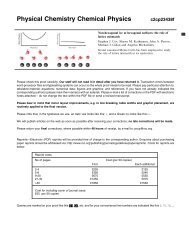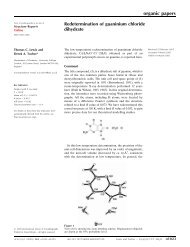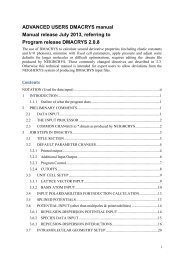An Introduction to the Theory of Crystalline Elemental Solids and ...
An Introduction to the Theory of Crystalline Elemental Solids and ...
An Introduction to the Theory of Crystalline Elemental Solids and ...
Create successful ePaper yourself
Turn your PDF publications into a flip-book with our unique Google optimized e-Paper software.
4<br />
FIG. 2: Schematic illustration <strong>of</strong> a typical energy-volume equation <strong>of</strong> state for a solid. The<br />
cohesive energy, E coh , is indicated.<br />
continuum <strong>of</strong> interactions that hold nature’s many <strong>and</strong> varied solids <strong>to</strong>ge<strong>the</strong>r <strong>and</strong> conclude<br />
that <strong>the</strong>re are five idealized types <strong>of</strong> bonding interaction, namely van der Waals, ionic,<br />
covalent, metallic, <strong>and</strong> hydrogen bonding. Let’s now consider each briefly in turn:<br />
• Van der Waals Bonding: These are <strong>the</strong> weakest bonding interactions <strong>and</strong> arise<br />
through <strong>the</strong> instantaneous induced dipole-induced dipole (dispersive) forces between<br />
a<strong>to</strong>ms [4]. The elements most commonly held <strong>to</strong>ge<strong>the</strong>r by van der Waals bonds are<br />
<strong>the</strong> rare gases Ne, Ar, Kr, <strong>and</strong> Xe [5]. These are <strong>the</strong> elements that have so-called<br />
filled valence shells. The layers <strong>of</strong> C in <strong>the</strong> graphite structure are also held <strong>to</strong>ge<strong>the</strong>r<br />
with van der Waals forces. The two overriding features <strong>of</strong> van der Waals forces are<br />
that <strong>the</strong>y are: i) non-directional; <strong>and</strong> ii) weak (compared <strong>to</strong> <strong>the</strong> o<strong>the</strong>r types <strong>of</strong> bonding<br />
that we shall discuss). This leads in most cases <strong>to</strong> close-packed structures with<br />
cohesive energies that rarely exceed a few hundred meV per particle.<br />
• Ionic Bonding: These are much stronger bonds than van der Waals bonds <strong>and</strong> arise<br />
through electrostatic attraction between oppositely charged ions. Typically this is realized<br />
in so-called ionic crystals such as <strong>the</strong> alkali halides in which an electropositive<br />
group I a<strong>to</strong>m transfers an electron <strong>to</strong> an electronegative group VII a<strong>to</strong>m resulting<br />
in two oppositely charged ions (in ra<strong>the</strong>r stable closed-shell configurations) which<br />
strongly attract each o<strong>the</strong>r. The resulting crystal structures that arise are those<br />
which <strong>of</strong>fer optimal packing <strong>of</strong> differently sized ions.<br />
• Covalent Bonding: Whilst ionic bonding is based on complete electron transfer between<br />
<strong>the</strong> a<strong>to</strong>ms involved in a bond, covalent bonding is realized through <strong>the</strong> somewhat<br />
opposite scenario (still in our idealized pictures) in which electrons are equally<br />
shared between <strong>the</strong> bonding partners through <strong>the</strong> overlap <strong>of</strong> orbitals on adjacent<br />
a<strong>to</strong>ms. Intrinsic <strong>to</strong> covalent bonding is <strong>the</strong>refore a strong directionality as opposed<br />
<strong>to</strong> <strong>the</strong> non-directional ionic or van der Waals bonds. As a result such materials do<br />
not necessarily adopt structures that arise from optimal crystal packing. Instead <strong>the</strong><br />
diamond <strong>and</strong> zincblende lattices are <strong>of</strong>ten favored.<br />
• Metallic Bonding: The conceptual idea behind metallic bonding is that <strong>the</strong> valence<br />
electrons are highly delocalized; shared among <strong>the</strong> “community” <strong>of</strong> a<strong>to</strong>ms in <strong>the</strong> solid<br />
<strong>and</strong> not localized on one particular a<strong>to</strong>m or pair <strong>of</strong> a<strong>to</strong>ms. In most abstract terms,







